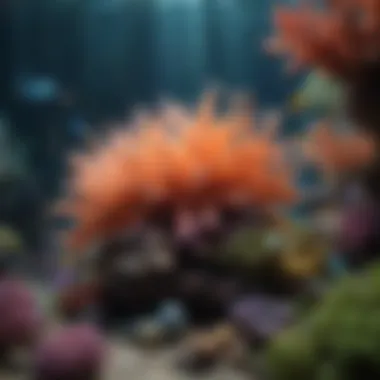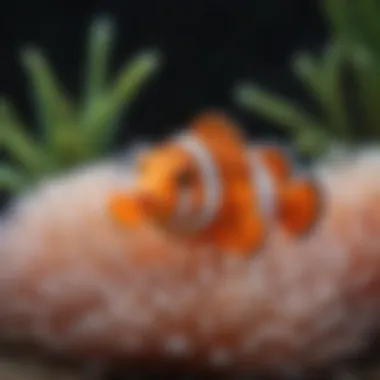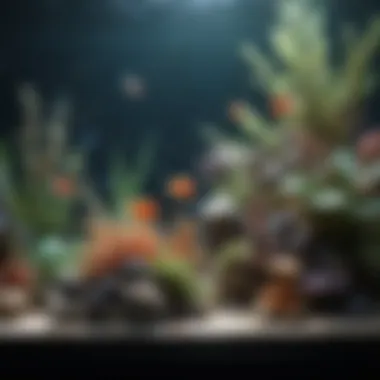Discovering the Best Saltwater Aquariums: A Complete Guide


Intro
Saltwater aquariums are a captivating blend of art and science. They create environments that replicate the complexity of natural marine ecosystems. This guide delves into the fascinating world of saltwater aquariums. It aims to enlighten both seasoned enthusiasts and newcomers alike. By emphasizing sustainable practices, we hope to promote responsible marine aquarium methods. Understanding the essentials of setup, species selection, and maintenance is key to success.
Ecosystem and Environment
Establishing a saltwater aquarium involves more than just filling a tank with water. It requires knowledge about the ecosystem it represents. Coral reefs, for example, are complex habitats that support a vast array of marine life. Replicating these conditions in a home aquarium requires planning.
Key Elements of a Saltwater Aquarium
- Tank Size: Selecting the right tank size is vital. Larger tanks tend to have more stable water parameters, easing the maintenance of a balanced ecosystem.
- Filtration System: A reliable filtration system is necessary to maintain water quality. Options include hang-on-back filters and canister filters.
- Live Rock and Sand: Live rock provides natural filtration and a habitat for beneficial bacteria. Live sand enhances the ecosystem and can host various organisms.
Exploring these components lays the foundation for a successful aquarium setup. Understanding these details enables owners to create a thriving aquatic environment.
Common Fish Species
Choosing the right species is crucial for any saltwater aquarium. Some popular choices include:
- Clownfish: Hardy and easy to care for, they adapt well to community tanks.
- Tang Fish: Known for their vibrant colors, they require more swimming space.
- Wrasses: Diverse in species, they help with pest control but need hiding spots.
Selecting compatible species prevents aggression and ensures a harmonious habitat.
Maintenance Practices
Regular maintenance is essential for long-term success. It helps maintain water quality and overall health of the tank. Here are some best practices:
- Routine Water Changes: Changing 10 to 20 percent of the water weekly helps to remove toxins.
- Testing Water Parameters: Regularly test for salinity, pH, ammonia, nitrate, and phosphate levels. This ensures a stable environment for the inhabitants.
- Scheduled Feeding: Adhere to a feeding schedule to prevent overfeeding, which can lead to water quality issues.
Engaging with these maintenance practices strengthens the aquarium's health.
Sustainable Practices
Engagement in sustainable practices is paramount for the longevity of marine life. Here are a few approaches:
- Research Local Species: Educate yourself on local species compatible with your setup.
- Support Ethical Sources: Obtain fish and live rock from sustainable and ethical suppliers. This helps in conserving marine ecosystems.
- Minimize Waste: Utilize efficient tank practices to reduce waste production and save resources.
By interacting with these practices, aquarists contribute to marine conservation efforts.
In summary, saltwater aquariums offer a unique opportunity to replicate ocean ecosystems. By understanding the necessary components and practices, both aesthetics and ecological responsibility can thrive together.
Preface to Saltwater Aquariums
Saltwater aquariums present a unique facet of aquatic pet ownership, offering a blend of beauty and complexity. These environments replicate marine ecosystems, allowing for a diverse array of organisms to thrive. This section will delve into what constitutes a saltwater aquarium, highlighting its distinctive characteristics and benefits.
What is a Saltwater Aquarium?
A saltwater aquarium, also referred to as a marine aquarium, is a habitat that contains saltwater, typically mimicking oceans or seas. Unlike freshwater systems, the water in saltwater aquariums has a higher concentration of salt and minerals. This type of aquarium supports various life forms, including fish, coral, and invertebrates.
The salinity level in these aquariums usually ranges from 1.020 to 1.025 specific gravity. This environment is essential for the survival of marine species, which rely on specific water chemistry. Understanding these requirements is fundamental for anyone considering setting up such an aquarium.
Marine aquariums can be categorized into two types: fish-only systems and reef systems. Fish-only systems are focused primarily on fish species, while reef systems include corals and other invertebrates, creating a more complex ecosystem.
Benefits of Saltwater Aquariums
Constructing and maintaining a saltwater aquarium offers numerous advantages, which can enhance both the aesthetic and educational value of this hobby.
- Diverse Marine Life: Marine ecosystems boast a wide variety of species not found in freshwater, such as exotic fish and colorful corals. This diversity can inspire both owners and visitors alike.
- Visual Appeal: Saltwater setups can create stunning visuals with vibrant colors and dynamic movements. The interplay of light and water can produce an enchanting atmosphere.
- Educational Opportunities: Enthusiasts can learn about marine biology and ecology through observations in their own homes. This can be particularly beneficial for children and students.
- Environmental Contribution: Engaging in responsible fish keeping can support sustainable practices. Some aquarists participate in propagation and restoration of coral species, contributing positively to marine conservation efforts.


It is essential to understand that a saltwater aquarium requires more rigorous maintenance compared to freshwater systems. This includes consistent monitoring of water parameters and regular tank upkeep.
Key Components of Saltwater Aquariums
Understanding the key components of saltwater aquariums is essential for anyone looking to create a thriving marine environment. These elements work together to support the unique needs of marine life and maintain the delicate balance required for such ecosystems. Adequate knowledge about tank selection, filtration, heating, lighting, and substrate can significantly enhance both the aesthetics and health of the aquarium.
Tank Selection and Size
The size and type of tank you choose can affect everything from water quality to the types of marine life you can keep. Generally, larger tanks provide more stable environments. This is due to the greater volume of water, which helps dilute toxins and buffer against sudden changes in water parameters. Smaller tanks can be more challenging to maintain as they require careful monitoring. It’s advisable to consider your available space and budget when selecting a tank.
Filtration Systems
A filtration system is vital for any saltwater aquarium. It helps maintain water clarity and health by removing debris and harmful substances. There are various types of filtration systems, and understanding each can aid in selecting the right one for your aquarium needs.
Mechanical Filtration
Mechanical filtration involves physically removing particles from the water. This is often done using sponges or filter pads. The main advantage of mechanical filtration is its effectiveness in keeping the water clear of larger particles like uneaten food or waste. One key characteristic of mechanical filtration is its simplicity. However, it requires regular maintenance to clean or replace the filter media to prevent clogging. As such, it is a popular choice for beginners, providing a straightforward method to maintain water quality.
Chemical Filtration
Chemical filtration uses materials like activated carbon to remove dissolved organic compounds, odors, and discoloration from the water. This type of filtration is essential for maintaining high water quality. A significant advantage of chemical filtration is its ability to target specific contaminants, leading to cleaner water. However, it requires periodic replacement of the filter media to ensure its effectiveness, making it a bit more involved than mechanical filtration.
Biological Filtration
Biological filtration relies on beneficial bacteria to break down harmful ammonia and nitrites in the water. This is crucial for maintaining a healthy aquarium environment. The key characteristic of biological filtration is that it works invisibly, converting waste products into less harmful substances. It offers a long-term solution to waste management in aquariums, but establishing an effective biological filtration system can take time. A disadvantage is that it can be disrupted by sudden changes in water conditions, such as those from overfeeding.
Heating and Lighting
Heating and lighting are vital components of a saltwater aquarium, affecting both the health of marine life and the growth of corals. Proper heating maintains a stable temperature that is crucial for the well-being of aquatic species. Meanwhile, adequate lighting is essential for photosynthetic organisms like corals. Light intensity and spectrum need to be tailored to the specific needs of the marine life in your tank.
Substrate and Hardscape Options
The type of substrate and hardscape used in the aquarium can have a significant impact on the aesthetic and functional aspects of the tank. Common substrates include sand, which promotes a natural look and is beneficial for certain marine organisms. Hardscape options, such as rocks and driftwood, provide hiding spots and territories for fish. It is important to choose materials that will not alter the water chemistry, ensuring a safe environment for all inhabitants.
Marine Life Selection
Choosing the right marine life is crucial for the success of a saltwater aquarium. This selection influences the overall health and aesthetic appeal of the aquarium, as well as the well-being of its inhabitants. Each species has unique care requirements, social behaviors, and environmental needs. Understanding these aspects is vital for creating a balanced ecosystem that not only flourishes but also mirrors the complexity of oceanic habitats.
Types of Fish for Saltwater Aquariums
When considering fish for your saltwater aquarium, diversity is key. There are numerous species, each offering unique colors, patterns, and behaviors. Some popular choices include:
- Clownfish: Known for their bright colors and hardiness.
- Tang: Offers dynamic movements and vibrant appearances.
- Wrasse: Comes in various sizes and colors, known for their active behavior.
Selecting fish involves more than just aesthetic appeal. It's important to consider compatibility and size. Some fish require specific tank mates to thrive, while others may exhibit territoriality. Researching individual species will help prevent unnecessary stress and ensure a harmonious environment.
Invertebrates and Corals
Invertebrates and corals play an integral role in a saltwater ecosystem. They contribute to the biodiversity and can enhance the visual appeal of the aquarium. Common invertebrates include:
- Shrimp: Such as cleaner shrimp that help maintain tank cleanliness.
- Snails: Like turbo snails, which are excellent algae grazers.
Corals, on the other hand, require special attention and care. They rely on stable water parameters and appropriate lighting. Some coral options are more forgiving for beginners, such as soft corals, while others are more demanding.
The introduction of these species can provide essential benefits like natural filtration, habitat structures, and organic waste breaks down. Their presence is part of what makes a reef tank truly captivating.
Compatibility Considerations


Compatibility is a significant factor when selecting marine life. An incompatible mix can lead to stress, illness, or even death among tank mates. Here are some tips for ensuring compatibility:
- Research Species: Understand the temperaments and territorial behaviors of various fish and invertebrates.
- Tank Size: Ensure that your aquarium is large enough to accommodate a diverse range of species without overcrowding.
- Behavior Patterns: Some fish are more aggressive, while others are peaceful. This knowledge is important when mixing species.
“A harmonious aquarium relies on careful compatibility of its inhabitants.”
Overall, thoughtful fish and invertebrate selection is essential for maintaining a thriving saltwater aquarium that remains both healthy and visually stunning.
Setting Up Your Saltwater Aquarium
Setting up a saltwater aquarium is a critical step for anyone interested in marine life. This process lays the foundation for a healthy ecosystem. The setup phase is vital as it determines the environment for the creatures you select. Getting it right ensures the well-being of fish and corals, while also making maintenance easier in the long run.
Initial Setup Steps
When starting the setup of your saltwater aquarium, several key processes need your attention. First, select a suitable location. It should be away from direct sunlight and sources of heat. Next, consider the size of your tank. Bigger tanks are generally easier to maintain as they hold more water, which helps stabilize water parameters.
- Gather Your Equipment: You will need a tank, filtration system, heater, lighting, and substrate. Ensure all equipment is compatible with saltwater use.
- Set Up the Tank: Start placing the substrate. Avoid using sand, as it can cloud the water. Instead, a reef-grade mix is preferable. Add rocks and other hardscape materials to create hiding spots for fish.
- Install Equipment: Once the substrate and hardscape are in place, set up the filtration and heating systems. Ensure they function properly before filling the tank with water.
- Add Saltwater: Mix the appropriate amount of marine salt with dechlorinated water. Use a hydrometer to check the specific gravity, ensuring it matches the needs of your chosen marine life.
- Position Decor: After filling the tank, adjust any rocks and corals to your liking. This step can influence both aesthetic appeal and the comfort of your fish.
By following these steps, you create a base for a thriving marine ecosystem.
Cycling the Aquarium
Cycling is an essential process that allows beneficial bacteria to establish before adding marine life. It helps convert harmful ammonia and nitrites, which can be toxic, into less harmful nitrates. A well-cycled aquarium can significantly reduce stress for new fish.
There are two primary methods for cycling your aquarium:
- Fish Cycle: This method involves introducing a few hardy fish. Over time, their waste produces ammonia, promoting bacterial growth. However, this method can stress the fish.
- Fishless Cycle: This safer method uses ammonia directly, eliminating the risk to fish. Add pure ammonia to the tank, allowing bacteria to establish without any fish present.
The cycling process usually takes four to six weeks. During this time, monitor water parameters consistently.
Important: Always test your tank for ammonia, nitrite, and nitrate levels. Regular testing helps ensure your aquarium is ready for fish life.
Maintenance and Care
Caring for a saltwater aquarium is not just about aesthetics. It is vital for maintaining the health of marine life and ensuring the ecosystem remains balanced. Proper aftercare fosters a thriving environment. It influences fish behavior, coral growth, and overall system stability. Neglecting maintenance can lead to harmful conditions, which may result in the loss of aquatic life. Having a structured routine for care is essential. This ensures a vibrant, sustainable marine aquarium.
Regular Maintenance Tasks
Regular maintenance tasks are the backbone of a successful saltwater aquarium. These tasks include:
- Water Changes: Performing regular water changes is one of the most effective ways to keep the aquarium healthy. It helps to remove toxins and replenish beneficial minerals.
- Cleaning: Regular cleaning of the tank, filters, and equipment prevents buildup of debris. This is crucial for preventing disease in marine life.
- Equipment Checks: Periodic inspections of pumps, heaters, and lights ensure everything is functioning well. Addressing issues immediately can save both resources and marine life.
Incorporating these tasks into a routine will enhance the aquarium’s longevity and health.
Testing Water Parameters
Testing water parameters is vital for every aquarist. Parameters such as pH, salinity, ammonia, nitrite, and nitrate levels need to be monitored closely. Each parameter plays a significant role in the wellbeing of marine organisms.
- pH Levels: Should generally be between 7.8 and 8.5. Frequent testing helps identify fluctuations, which can stress fish and corals.
- Salinity: Maintain salinity levels, which are essential for osmotic balance in marine life.
- Ammonia and Nitrite: These should be at zero, as even trace amounts can be harmful to fish.
- Nitrate Levels: Ideally below 20 ppm to prevent algae blooms.
Using kits or digital testers provides reliable results. Keeping records of these tests helps observe trends over time. This aids in proactive management of the saltwater environment.
Handling Common Problems
Virtual marine sanctuaries require knowledge about potential problems that may arise. Common issues can be addressed effectively when recognized early.
Ailments in Marine Fish


Ailments in marine fish can vary widely. Recognizing symptoms is crucial for a rapid response. Common conditions include:
- Ich: A disease caused by parasites. Visible white spots appear on the skin. Treatment involves using medication and increasing temperature.
- Fin Rot: Caused by poor water quality or bacterial infection. Treatment necessitates improving water conditions and sometimes using antibiotics.
Prompt action helps manage these ailments before they become severe. Understanding the common diseases helps aquarists maintain a healthy marine environment.
Algae Control
Algae control is essential in maintaining water quality and visual appeal. Certain types of algae are beneficial, while others can quickly become problematic. Key strategies include:
- Manual Removal: Regularly remove excess algae by scraping or using a soft brush.
- Beneficial Companions: Introducing herbivorous fish or invertebrates can help reduce algae growth.
- Lighting Management: Adjust light duration and intensity. Reducing light can limit algae growth significantly.
Implementing these strategies keeps algae in check and helps maintain the aquarium’s ecosystem balance.
Coral Issues
Corals are sensitive and can experience several issues. They thrive in stable environments, where water parameters are carefully managed. Common problems include:
- Bleaching: A sign of stress often due to changes in water conditions or light. Recovery might be slow and requires stable conditions.
- Diseases: Corals can suffer from various diseases. Observing for changes in color or polyp retraction is important.
Understanding these factors enhances the success of keeping live corals. Healthy corals contribute significantly to the beauty and stability of the aquarium.
Regular maintenance and awareness of potential problems in saltwater aquariums can create a harmonious aquatic environment. This not only benefits the owners but also supports marine life effectively.
Sustainability in Saltwater Aquarium Keeping
Sustainability in saltwater aquarium keeping is crucial not just for the health of the marine ecosystems we recreate, but also for the future of our oceans. This aspect of aquarium management addresses the persistent issues of overfishing, habitat destruction, and the ecological impact of marine life collection. By integrating sustainable practices, aquarists can contribute positively to the planet while enjoying the beauty and complexity of saltwater tanks.
Sustainable practices in saltwater aquariums provide multiple benefits. Firstly, they help ensure that fish populations remain viable in their natural habitats. Over-collection can lead to local extinctions and loss of biodiversity. Secondly, sustainable aquarium practices can also reduce the negative impact on marine habitats, allowing ecosystems to recover. Ultimately, it leads to healthier aquariums as well, fostering a balance that benefits both marine creatures and aquarists.
Ethical Sourcing of Marine Life
Ethical sourcing refers to obtaining marine life in a way that does not harm the population or ecosystem. Several guidelines should be followed to ensure that marine life is collected sustainably. For instance, wild populations should not be collected beyond their resilience. This approach includes respecting the breeding cycles of fish and the conservation efforts in place for fragile species.
Aquarists can support ethical sourcing by choosing to purchase captive-bred specimens whenever possible. Captive-bred fish are often more adaptable to aquarium life and less likely to harbor diseases common in wild-caught fish. Moreover, many businesses now practice responsible sourcing, emphasizing sustainable collection methods, offering transparency in their operations. It is advisable to conduct research on suppliers to see their practices in relation to ethical sourcing.
Promoting Marine Conservation
Promoting marine conservation within the saltwater aquarium community is essential for protecting oceanic health. Aquarists play a pivotal role by seeking to understand and address pressing issues such as pollution, climate change, and habitat degradation. They can engage in conservation by participating in local and global efforts to clean up oceans and restore marine habitats.
Additionally, many aquarium societies and organizations offer programs and initiatives dedicated to marine conservation. Joining these efforts creates a more substantial impact than individual actions. By supporting policies that promote sustainable fishing and habitat protection, aquarists directly contribute to the conservation of marine ecosystems.
It is critical for aquarium enthusiasts to recognize their impact on marine environments. Every decision we make in this hobby can either contribute to sustainability or detriment.
By being vigilant and proactive, individuals dedicated to saltwater aquariums can foster a culture of responsibility and stewardship that benefits both their tanks and the oceans at large.
Closure
Understanding the intricacies of saltwater aquariums is essential for both novice and seasoned aquarists. This comprehensive guide covers the multifaceted dimensions of maintaining a vibrant saltwater ecosystem. It highlights critical aspects, such as setup procedures, selection of marine species, and the enduring necessity of regular maintenance. Additionally, sustainable practices are central for aquarium enthusiasts who aspire to contribute positively to marine life conservation.
"A well-maintained saltwater aquarium can be a beautiful and tranquil addition to any home, while also serving as a microcosm of the world's oceans."
Summary of Key Points
Throughout this article, key themes were discussed that underline the significance of saltwater aquariums:
- What is a Saltwater Aquarium? An exploration of its definition and the unique ecosystems it can replicate.
- Benefits of Saltwater Aquariums: Highlighting aesthetic appeal and educational opportunities.
- Key Components: Discussing essential aspects like tank selection, filtration systems, and heating.
- Marine Life Selection: Delving into appropriate species and compatibility factors.
- Setup and Maintenance: Step-by-step guidance from initial setup to long-term care.
- Sustainability Practices: Emphasizing the importance of ethical sourcing and conservation efforts.
These points collectively inform readers about creating and maintaining a healthy saltwater aquarium.
Final Thoughts on Saltwater Aquariums
Saltwater aquariums offer both challenges and rewards. For pet owners and marine enthusiasts, they embody a connection to oceanic life that is unparalleled. While setting up and maintaining such systems requires diligence, the result is often a visually stunning environment that reflects the beauty of marine habitats. Engaging with saltwater aquariums is more than a hobby; it is a commitment to understanding and preserving our oceans.
By prioritizing sustainability and ethical practices, aquarists can ensure a balance between personal enjoyment and ecological responsibility. The world of saltwater aquariums is vast and filled with opportunities for learning and appreciation. With proper knowledge and care, anyone can embark on this rewarding journey.















